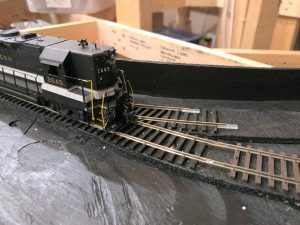Everyone with a layout has that “special” locomotive. No, not your favorite one with the custom paint and weathering or the one with the beautiful sound system. You know, it’s the one that despite every effort you’ve made to make sure there’s nothing obstructing free movement, there’s nothing dragging, and all the wheels are in perfect gauge, still manages to find ways to fail to stay on the rails where 100s of others have succeeded before. . . that kind of special. These locomotives serve a wonderful purpose, but I’ll get to that later.
My special locomotive is Southern GP35 2649. It’s a kitbashed Athearn model with a high nose and Alco-style truck sideframes. There’s nothing remarkable about the drive system, wiring, or anything else–if anything, it might be a tad on the light side.
For the last month, I’ve been running trains on my staging level. It’s been a great exercise in working out the kinks in the trackwork and power, getting re-acquainted with my DCC system and JMRI DecoderPro, and just enjoying watching some trains run. I’ve gotten to the point where I could back a 34-car train of empty hoppers with 3 units shoving all the way around the layout and through all three of the reversing loop tracks–I was pretty proud of my work! Then came the Special. . .

Southern 2649 never got a lot of running time on my last layout as it was one of the last locomotives to make it to running shape before I had to tear things down. I decided to break it in a bit more today by running it in loops around the staging level. First long-hood forward–no problem, negotiated everything like a pro for 30 minutes! Ok, let’s reverse direction–looking good, going through the last switch. . . on the ground. Hmm. put it back on the rails, backed up, through the last switch. . . on the ground again. I repeated this process several times and determined it wasn’t the switch, but it was running over the outside rail right at the transition between hand-laid switch track and flex track. I felt the track joint–smooth as it could be. I checked the gauge–spot on. I re-soldered the joint anyway. . . on the ground. I could propel the engine over the spot by hand with no issues, but as soon as it was under its own power, it would climb right over the rail–infuriating!
I removed the brake cylinder piping on the front truck to make sure it wasn’t catching. . . on the ground. I took off the truck sideframes and smoothed out the backs of the brake cylinders to make sure they weren’t catching. . . on the ground. I finally went back to the soldering iron and re-did the entire track joint, using a screwdriver to lift up the rail a bit and a pair of pliers to push one rail further in to provide a little more curve to the rail before hitting the joint. Let’s see, will 2649 like it? . . . I stood there, looking like an expectant father who’s watched his kid fall 100 times learning to ride a bike and thinking “maybe, just maybe this time will be the one!”
Lo and behold, 2649 made it through! I watched proudly as it circled the layout like a champ, passing yard after yard of flex track, across the last switch before making it back to the starting point, and then “bah, dah, dah, dah, dah, dah”. . . the telltale sound of wheels on ties. Sigh. At least this time it was an easy diagnosis, a spike I had put on top of a rail joiner to hold it more securely in place was just a little too high. Yes, every other wheel on the layout had passed this joint 1,000s of times without incident, but alas, 2649 can find any flaw!
And that’s why I’m happy to have the very special 2649 on the roster. With 24″ radius curves, S-curves through switch ladders, and even some #4 curved turnouts, the track work on this layout needs to be flawless to be reliable. And it’s not flawless until 2649 says it’s flawless! As frustrating as its finicky nature may be, 2649 makes me a better modeler, and that’s what makes it truly special.
Hello, I am really enjoying the ride along as you toil on the railroad. I would love to model that same area some time. In researching the area, I came across the site “HistoricAerials.com”, which is loaded with period maps and aerial photos of the loaders and tipples of the line. It shoed the loader and track arrangements for Maness, Penn Lee, Dominion, Pocket and all the rest. It is very cool. I do not have any connection to or financial interest in this site, just coal roads. Respectfully, Moe
Yes, Dan, every layout needs a 2649! I have one too, an Atlas Geep 38 that finds the flaws.